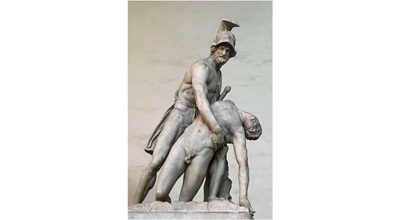|
ONLY A FEW DAYS LEFT!!!!!! I'm pumped to start looking at Hellenistic Art and Architecture with you all in class.
What is it like to study art history? Scholars constantly look at the smallest details of each statue, question them, and constantly ask themselves "why?" and "how?" For example: Why are the lips parted? Why are the eyes facing down? How does this statue express emotion? How did the politics and social situations of the time motivate the creation of this statue or temple? Why did they use bronze or marble? Why is a statue nude and what is the effect of that nudity? How did the original location of the statue affect its dimensions and structure? Those are the very issues we will be tackling as well. You can start thinking about these questions on your own over the next couple days with any medium of art. In particular, music provides plenty of examples: Why is Walk the Moon's song "Shut up and Dance with Me!" so popular? What is it about the tempo, the instruments involved, the refrain, and the tone that contribute to its catchy tune? What is the difference between Holst's masterpieces "Mars" and "Jupiter" and how does Holst achieve the emotional effects of both intensity in one and joy in the other? What instruments, rhythms, and tones are used and what are their purposes? COOL STUFF. To give you a quick teaser, I've attached a picture of my FAVORITE sculpture group from Hellenistic Art. This piece, the "Pasquino Group" represents a fleeting moment (2 lines) from the Iliad in which Menelaus holds Patroclus' collapsed body on the battlefield. I love the emotional intensity in this statue group and how it effectively embodies a powerful and overwhelming moment of grief and despair. I cannot wait to get started!!!! --Magistra Ghosheh
0 Comments
Your comment will be posted after it is approved.
Leave a Reply. |
Salvete Omnes!This blog will document the MMXVI session of the Virginia Governor's Latin Academy. After elections are held, the aediles will be responsible for its upkeep. Contact Us GLA Checklists
Download these and use them to help with packing: GLA Clothing Checklist GLA Essentials Checklist GLA School Supplies & Optional Checklist Suggested Texts-
NOT REQUIRED Again, these are not required and I would only get one from each category, if any. Latin Lexicons a. Conversational Latin for Oral Proficiency b. Cassell's Concise Latin-English, English-Latin Dictionary c. Collins Latin Concise Dictionary Greek Texts/Lexicons a. Homeric Greek: A Book for Beginners b. Liddell and Scott's Greek-English Lexicon Abridged c. Pocket Oxford Classical Greek Dictionary Translation Texts a. Iliad b. Thyestes Daily Life Books a. Everyday Life in Ancient Rome b. Peoples of the Roman World c. A Day in the Life of Ancient Rome d. Daily Life in the Roman City Vestes Romanae
You will need Roman clothing for several of our activities. You might not always have much time between these events, so you might want to bring more than one outfit. Patterns An Overview I & II Roman Dress Simple Tunica, Stola, and Palla Patterns Legio XX's Civilian Clothing Another Simple Dress Pattern Greek Patterns Simple Tunic and Toga Patterns Peplos Pattern Legio XX's Military Clothing Officers of the Academy
Consules: Mitch and Graham Censores: Liz and Blake Praetores: Bryant and Elizabeth Ne Aediles: Kathryn and Anshu Tribunes: Kirby Ann and Will Quaestores: Analise and Ben G |

 RSS Feed
RSS Feed